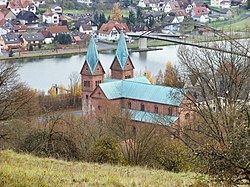
Amorbach Abbey was a Benedictine monastery located at Amorbach in the district of Miltenberg in Lower Franconia in Bavaria, Germany.

Schönrain Priory was a house of the Benedictine Order located near Lohr in the Spessart, in Bavaria in southern Germany. Few signs of the monastic buildings are visible today. The ruins that remain mostly consist of later additions when the structure served as a temporal dwelling and foresters' lodge.

The Comburg (help·info) is a former Benedictine monastery near Schwäbisch Hall, Germany.
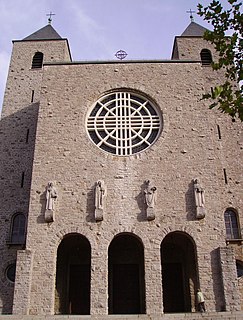
Münsterschwarzach Abbey, is a Benedictine monastery in Germany. It is located at the confluence of the rivers Schwarzach and Main in Bavaria.
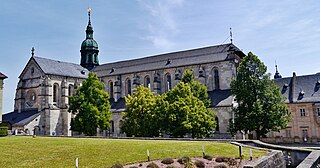
Ebrach Abbey is a former Cistercian monastery in Ebrach in Oberfranken, Bavaria, Germany, now used as a young offenders' institution.
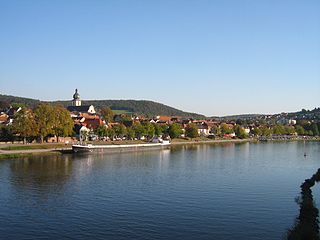
Marktheidenfeld is a town in the Main-Spessart district in the Regierungsbezirk of Lower Franconia (Unterfranken) in Bavaria, Germany and the seat of the Verwaltungsgemeinschaft of Marktheidenfeld. The town has around 11,000 inhabitants.

Rothenfels is a town in the Main-Spessart district in the Regierungsbezirk of Lower Franconia (Unterfranken) in Bavaria, Germany and a member of the Verwaltungsgemeinschaft of Marktheidenfeld. With a population of just around 1,000 it is said to be Bavaria’s smallest town.
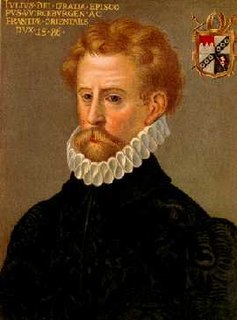
Julius Echter von Mespelbrunn was Prince-Bishop of Würzburg from 1573. He was born in Mespelbrunn Castle, Spessart and died in Würzburg.

Mespelbrunn is a community in the Aschaffenburg district in the Regierungsbezirk of Lower Franconia (Unterfranken) in Bavaria, Germany and a member of the Verwaltungsgemeinschaft of Mespelbrunn, whose seat is in Heimbuchenthal.

Neustadt am Main is a community in the Main-Spessart district in the Regierungsbezirk of Lower Franconia (Unterfranken) in Bavaria, Germany and a member of the Verwaltungsgemeinschaft Lohr am Main.

Steinfeld is a community in the Main-Spessart district in the Regierungsbezirk of Lower Franconia (Unterfranken) in Bavaria, Germany and a member of the Verwaltungsgemeinschaft of Lohr am Main.

Markt Triefenstein is a market community in the Main-Spessart district in the Regierungsbezirk of Lower Franconia (Unterfranken) in Bavaria, Germany. It was created in 1978 out of the villages Homburg am Main, Lengfurt, Rettersheim and Trennfeld.

St. Burchard's Abbey was a Benedictine monastery in Würzburg, Germany, initially known as St. Andrew's Abbey. It was the first abbey established in Würzburg, founded ca. 750. In 1464, it was transformed into a Stift.

Grünau Charterhouse is a former Carthusian monastery, or charterhouse, in Schollbrunn in Bavaria, Germany. It was the first Carthusian monastery in Franconia and in today's Bavaria.

Michaelsberg Abbey or Michelsberg Abbey, also St. Michael's Abbey, Bamberg is a former Benedictine monastery in Bamberg in Bavaria, Germany. After its dissolution in 1803 the buildings were used for the almshouse Vereinigtes Katharinen- und Elisabethen-Spital, which is still there as a retirement home. The former abbey church remains in use as the Michaelskirche.

Hafenlohr is a river of Bavaria, Germany. It is around 28 km (17 mi) long and discharges into the Main at the town of Hafenlohr. The Hafenlohr is located in the districts of Aschaffenburg and Main-Spessart in the Lower Franconia region.

Salzburg Castle stands on the edge of a plateau above the town of Bad Neustadt an der Saale in Lower Franconia in southern Germany. The large Ganerbenburg is still partly occupied today and not all areas are accessible to the public.

Kloster Allerheiligen is a former Benedictine monastery in the Swiss municipality of Schaffhausen in the Canton of Schaffhausen. The church Münster Allerheiligen is the oldest building in Schaffhausen, and houses also the Museum zu Allerheiligen.

Kloster Engelberg is a Franciscan monastery in Grossheubach in Bavaria, Germany. In the past, a pilgrimage dedicated to a figure of Mary, documented as far back as 1406, was administered by the Capuchins after 1630. Following secularization in the early 19th century, the Capuchins eventually left and the Franciscan order took over the abbey and caring for the pilgrims. The abbey is (partially) open to the public.

Hornbach Abbey is a former monastery founded around 741 in the historic town of Gamundias by Saint Pirmin, which soon became a Benedictine abbey. The most important neighbouring abbeys were Bausendorf, Saint-Avold, Glandern, Villers-Bettnach, Fraulautern, Mettlach, Tholey, and the stift of St. Arnual. The neighboring spiritual centers were Trier and Metz. At present, all that remains of Hornbach Abbey are the structural remains of the convent buildings, which have been supplemented by a monastery museum, and a modern chapel with the historical tomb of the monastery's founder.
